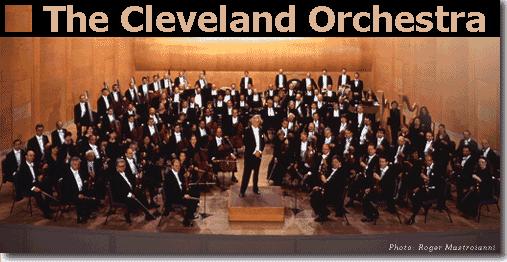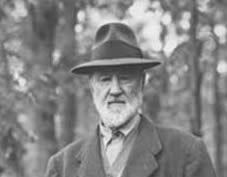
As an observance of some of the best expressions of patriotism and independence over this long weekend I put on a fine CD recorded by the Cleveland Orchestra and Chorus circa 1994 conducted by Christoph von Dohnanyi (with Jahja Ling listed as the "second conductor" for the one piece that requires two and Gareth Morrell as the director of the chorus).
 This program begins with a well-rehearsed performance of Ameriques by Edgard Varese. Imaginatively stretching the boundaries of symphonic timbre and language this incredible piece employs a huge battery of percussionists to paint an ambitious sonic landscape. I prefer the original version composed in 1918-1921 (performed magnificently by the Royal Concertgebouw Orchestra on Varese: The Complete Works), but this scaled-down version is impeccably executed and a satisfying dose of Varese's unique sound. This piece is widely regarded as Varese's first work in the style that would become so identifiably his own. It is fitting that Varese regarded the title as a reference to "symbolic of discoveries -- new worlds on earth, in the sky, or in the minds of men." The way these jagged sonic pieces fit together - part contra puntal texture, part Varesian percussive sensibility - rewards the attentive listener and alludes to discoveries still left unexplored almost a full century later.
This program begins with a well-rehearsed performance of Ameriques by Edgard Varese. Imaginatively stretching the boundaries of symphonic timbre and language this incredible piece employs a huge battery of percussionists to paint an ambitious sonic landscape. I prefer the original version composed in 1918-1921 (performed magnificently by the Royal Concertgebouw Orchestra on Varese: The Complete Works), but this scaled-down version is impeccably executed and a satisfying dose of Varese's unique sound. This piece is widely regarded as Varese's first work in the style that would become so identifiably his own. It is fitting that Varese regarded the title as a reference to "symbolic of discoveries -- new worlds on earth, in the sky, or in the minds of men." The way these jagged sonic pieces fit together - part contra puntal texture, part Varesian percussive sensibility - rewards the attentive listener and alludes to discoveries still left unexplored almost a full century later. Next up on the Independence Day program is Symphony No. 4 by Charles Ives. This piece is a great contribution to the symphonic canon by an icon who advanced American art music early in the 20th Century. This is the work where Ives uses two conductors to recreate the sound of two marching bands playing independently as they march toward one another. The polytonal, polytempo sound is anchored by the use of quoted materials. Hymn tunes and military marches are used to paint a fond sonic image of the New England of Ives's youth without becoming sentimental.
Next up on the Independence Day program is Symphony No. 4 by Charles Ives. This piece is a great contribution to the symphonic canon by an icon who advanced American art music early in the 20th Century. This is the work where Ives uses two conductors to recreate the sound of two marching bands playing independently as they march toward one another. The polytonal, polytempo sound is anchored by the use of quoted materials. Hymn tunes and military marches are used to paint a fond sonic image of the New England of Ives's youth without becoming sentimental.The Independence Day program then concludes with The Unanswered Question by Chales Ives. This is a short symphonic work that features a solo trumpet line that sounds unresolved, like a question. This is one of my favorite Ives compositions and this performance sounds a little timid. The New York Philharmonic/Leonard Bernstein recording from 1990 is much more satisfying and I find myself reaching for that version once this disc has run out.
-----------
The Dallas Morning News ran this miserable article by Scott Cantrell as part of its Independence Day observance. There have been several articles and blogs about the "gay American" sound spurred by the recent publication of The Queer Composition of America's Sound: Gay Modernists, American Music, and National Identity by Dr. Nadine Hubbs.
The idea that homosexual identity = consonant tonality / heterosexual identity = dissonant atonality is incredibly insulting. And it offers yet another excuse for journalists and writers to write poorly or not at all about how music actually sounds. Sexual orientation is one thing. Musical aesthetics is another. It's artificial to assume that one has anything to do with the other. Dr. Hibbs tries to get off the hook by acknowledging the exceptions (such as "dissonant gay" composers like Henry Cowell or John Cage or "consonant straight" composers like Roy Harris or Walter Piston) but ultimately excludes them as anomalies. Actually, these "exceptions" point toward a significant weakness of the entire premise. You can argue any stupid thesis if you cherry-pick your supporting evidence. These exceptions are really exclusions as the set of American composers sited is absurdly small and heavily slanted. If you actually included a full range of American composers one would immediately see the absurdity of trying to pigeon hole a singular correlation between aesthetic and orientation. This is especially true when you consider composers who have adopted any number of different aesthetic positions over the course of their career while their orientation remained static.
Several lines from the Cantrell article are breathtakingly ignorant. Such as: "Arnold Schoenberg and his followers constructed music by mathematical formulas rather than sound." He apparently believes that statement requires no supporting evidence. Having actually heard the music of Arnold Schoenberg I find it hard to believe his harmonic innovations weren't motivated by sonic reality. One should say "Cantrell and his ilk write music opinion based on social prejudice rather than sound." The fact that so many of Schoenberg's contemporaries independently arrived at similar harmonic approaches at about the same time indicates that he was part of a natural growth toward extending harmony in the wake of Romanticism's reliance on chromaticism. One could work this idiotic logic backwards to condemn the "numerical dependence" of Beethoven's triadic harmony or Bach's canons. It's maddening that Cantrell can somehow see into the motivation of "Schoenberg and his followers" but cannot say one word about how it actually sounds. If there's a Pierrot Lunaire or Ewartung equation I would love to see it. After all, I've been listening to those "equations" for years now.
Another line of pure ignorance: "Melody and consonance were replaced by spiky disjunction, harmony by dissonance." This one doesn't make logical sense as "consonance" and "harmony" are not interchangeable terms. Harmony includes both 'consonance' and 'dissonance.' He might as well have said "color is replaced by orange." Or, given the sexual orientation-tilt of this article he could replace it with "pink" and keep on painting in gross stereotypes and generalizations.
-------------
Happy Independence Day.


No comments:
Post a Comment